Let’s start with the facts – you clearly love the wondrous four-legged friends that we call our companions. Why else would you be here?
You’ve undoubtedly heard of the Goldendoodle or the Labradoodle. Both are incredible breeds that combine fun and cuteness in one fun-filled package. But have you heard of the Irish Doodle?
Perhaps you’ve heard of these designer dogs by other names – the Irish Setter Poodle Mix, the Irish Doodle Setter, the Irish Setter Poo? Yep, they have a lot of nicknames. These fun, intelligent, and energetic pups are perfect for any family. Whether you’re alone or have a large family with children, this shaggy breed is a fantastic addition to your household.
So, if you’ve taken a liking to this designer breed, and want to learn more, then read on. This guide will tell you everything about the Irish Setter Poodle mix.
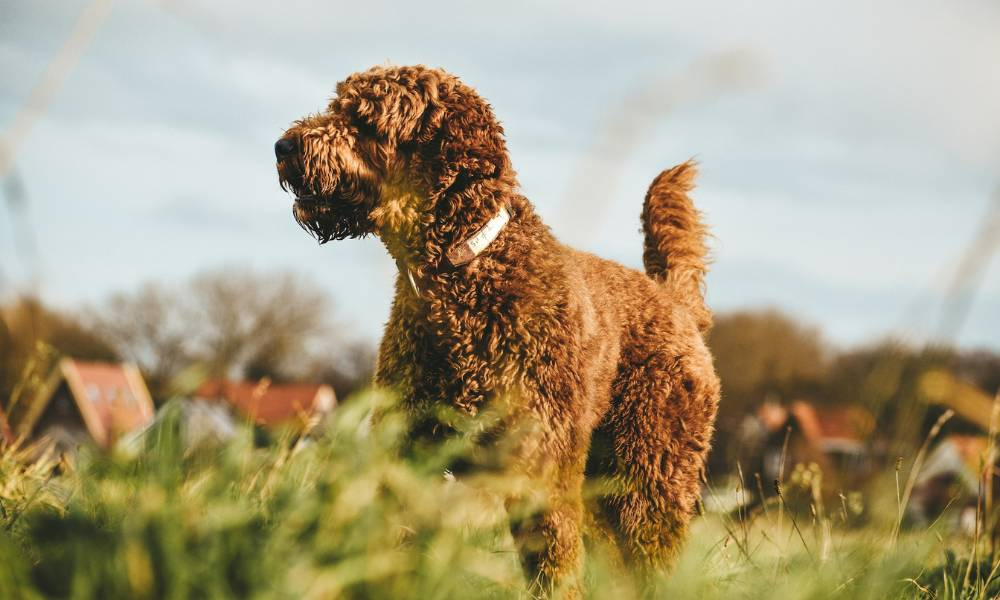
Photo by Thijs Scheper on Unsplash
Contents
- 1 1. What is an Irish Doodle?
- 2 2. The Parent Breeds: Irish Setter and Poodle
- 3 3. Irish Doodle Temperament and Personality
- 4 4. Irish Doodle Appearance
- 5 5. Taking Care of an Irish Doodle
- 6 6. Irish Doodle Life Expectancy
- 7 Common Health Concerns for the Irish Doodle
- 8 7. Pros and Cons of the Irish Doodle
- 9 Frequently Asked Questions About the Irish Doodle
- 10 Final Thoughts on the Irish Doodle
1. What is an Irish Doodle?
Simply put, Irish Doodle pups are a designer mixed breed that is part Irish Setter and part Poodle. They are a popular dog breed, likely due to their fun-loving and intelligent personalities but also because they are one of the best-behaved dog breeds you can get.
They inherited the best traits of the Irish Setter and Poodle, so you can expect them to be a great addition to your home. These canines are typically bred for their skills in hunting and retrieving. However, don’t let that fool you – they have plenty to offer the everyday family.
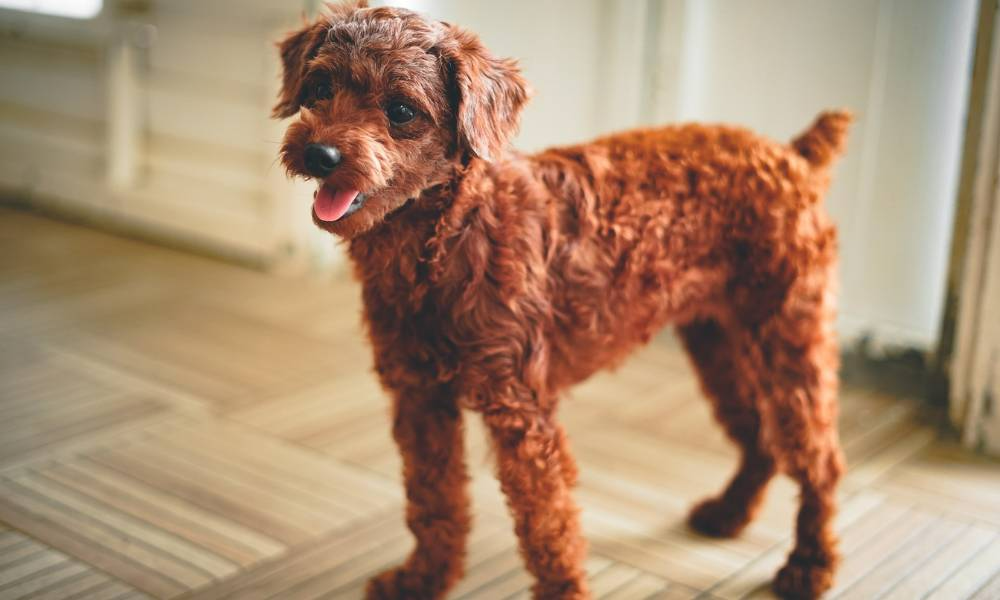
Photo by Afif Ramdhasuma on Unsplash
For starters, the Irish Doodle is known to be quite affectionate, playful, and tolerant of children and strangers. Since they are considered a designer breed, they are often used in agility contests and contest training.
Like all dogs, this breed runs the risk of becoming agitated and anxious, especially without the proper mental and physical stimulation. But don’t worry – we will get more into that later.
To better understand this Doodle mix, you’ll want to know more about the parent breeds, the Irish Setter and the Poodle. Let’s take a bit of a closer look at each one.
2. The Parent Breeds: Irish Setter and Poodle
As mentioned, you will benefit from knowing more about each of the parent breeds for the Irish Doodle. The Irish Setter and the classic Poodle have insightful histories and characteristics that add to the fantastic mixed breed.
So, let’s get straight into it.
Irish Setter
The Irish Setter was first found as far back as the 16th century, from Ireland – that much you expected, hence their name. But did you know that they were initially used as gundogs or bird dogs? This means they were trained to retrieve birds and other hunted animals and return them to their owners.
Their popularity slowly increased over the years due to their beautifully-colored coat and usefulness in everyday life. The Irish Setter was later found to excel in all kinds of sports and areas of training. Their athleticism and grace can attest to why they are so frequently considered for dog shows.
To this day, Irish Setters are classified as sporting dogs and are used in similar ways, like hunting, retrieving, and competing in contests.
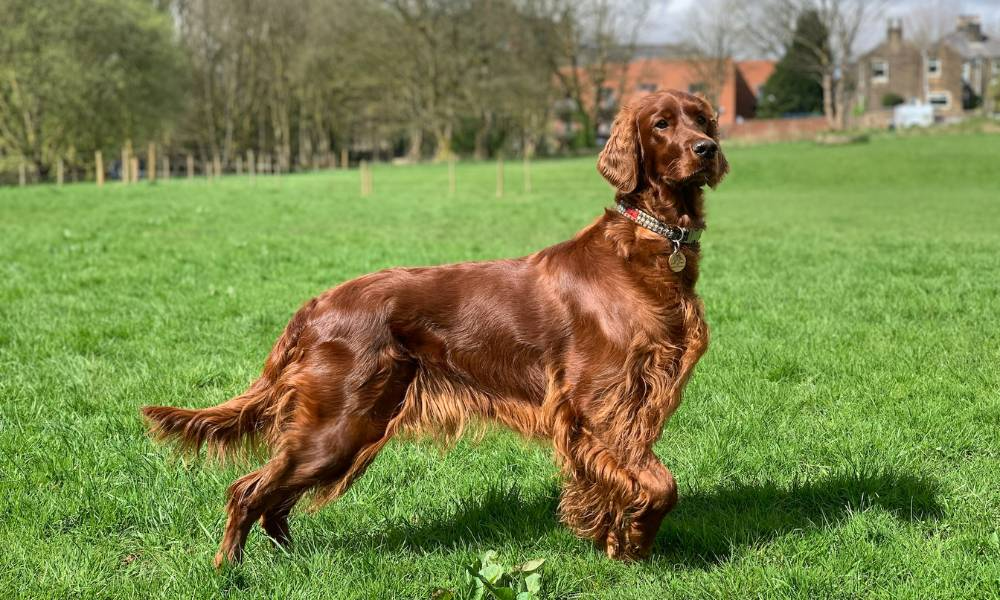
Photo by Dan Robinson on Unsplash
Poodle
When you think of the classic Poodle, you might associate it with high fashion, purses, or Paris! While some believe that the breed originated in France, the Poodle actually originates from Germany and dates back to the 14th century. The American Kennel Club recognized the breed in 1887, making this one of the very first registered breeds.
Quite different from the Irish Setter, the Poodle was primarily associated with Royalty and upper-class society. The standard-size Poodle was used for hunting and gathering. However, the miniature and toy poodle temperaments meant they could lounge in luxury alongside kings.
Seriously – did you know that French monarchs were always surrounded by poodles? The last of the French monarchy, King Louis XVI, and the famed Marie Antoinette both had toy poodles roaming their home. So, it is no surprise that some still refer to the breed as the French Poodle.
Nowadays, Poodles are common among celebrities, but regular families still enjoy the loveable and adorable designer breed.
3. Irish Doodle Temperament and Personality
There is a good reason that Irish Doodles are popular family pets. They are known to be extremely loving and caring towards their owners and families. They are also super social, so you can be sure they’d also give your visitors some attention.
Their sociability also contributes to their easygoing nature around the home. The Irish Doodle is not a loud dog – if anything, they barely bark. They tend to lounge around and enjoy the comfort of their owner’s company.

Photo by Kanashi on Unsplash
While very intelligent, the Irish Doodle isn’t considered the easiest dog to train. They are easily bored and unpredictable at times, but with a firm hand and persistence, they will pick up anything.
These dogs are also very loyal and make the perfect family dogs. As a bonus, they are super patient with children – what more could you want?
4. Irish Doodle Appearance
Now that you know more about their sweet personalities, let’s look at what the Irish Doodle looks like. The Irish Doodle is a medium-sized dog that can have various varieties of coat colors, snout shapes, and more.
One thing is for sure, though – they are one of the cutest dog breeds.
Size
Like both parent breeds, the Irish Doodle is considered a medium-sized dog. They tend to have a height of between 22 and 28 inches and a weight of between 40 and 70 pounds. This is dependent on whether they are male or female.
Male Irish Doodles are typically more prominent, with a height between 24 and 28 inches and a weight between 50 and 70 pounds. Conversely, females are between 22 and 26 inches tall and weigh between 40 and 60 pounds.
Eyes and Nose
The eyes of an Irish Doodle are a fantastic brown, like both parent breeds, without much variation. Then the snout of an Irish Doodle can be long and square, like an Irish Setter, or long and slender, like that of a Poodle. The nose color, however, is almost always black.
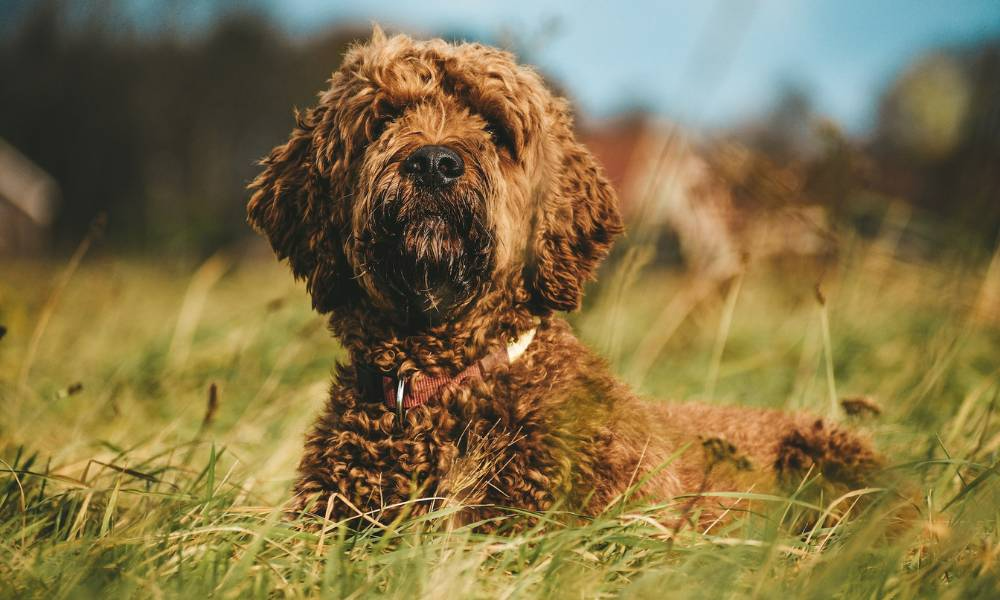
Photo by Thijs Scheper on Unsplash
Coat Appearance
The Irish Doodle can have any mixture of coat colors from their parent breeds. Irish Setters typically sport a sleek and straight red or mahogany coat for which they are famous. On the other hand, the coat of a poodle has a more tight-curled, short coat that comes in a white, black, or apricot color.
The coat of this pup will depend on its parents, of course. So, you can expect a long, wavy texture to their coat, combining both parent breeds. The color can be any mixture of red, mahogany, white, black, or apricot.
More often than not, though, the breed has a dark apricot coat leaning toward the red of the Irish Setter.
5. Taking Care of an Irish Doodle
Unlike a Pitbull and German Shepherd, the Irish Doodle is more low-maintenance than most dogs. But just because they don’t seem to need the same amount of care doesn’t mean you should pay less attention to the needs of these designer dog breeds.
If you are thinking of adding this precious pooch to your family, there are a few things you need to know. Let’s have a closer look at what it takes to provide the best possible care for your Irish Doodle.
Exercise
All dogs need physical and mental stimulation. That is a fact. However, your Irish Doodle doesn’t need a large amount of exercise as other dog breeds might. A moderate amount of daily activity keeps them happy and satisfied.
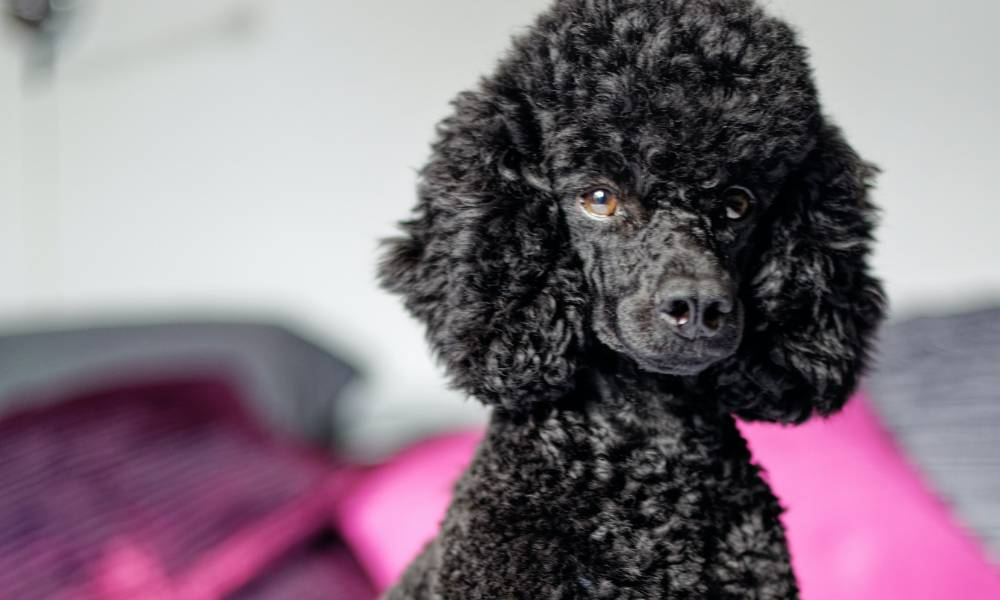
Photo by Lavi Cella on Unsplash
Their moderate energy levels mean they are often a good choice for those living in a smaller home or apartment. As long as they get some time outdoors and get a good 30 to 60 minutes of exercise each day, they will be perfectly fine.
You can never go wrong with grabbing that dog leash and taking them for a walk every day. Plus, there are always benefits to giving them plenty of time to play in the sunny outdoors. They’d also do well with the occasional trip to the dog park, playing some fetch, or with a dog frisbee.
When you can’t play with them consistently, feel free to keep their mind occupied with some treat puzzle toys or lick mats. That way, they can keep busy and get that mental stimulation that all dogs benefit from.
Training
As previously mentioned, the Irish Doodle isn’t as easy to train as other dogs. But that doesn’t mean Irish Doodle puppies are untrainable altogether. If you are consistent, adopt the proper techniques, and start as soon as possible, they will make your job easy.
The best strategy when training your dog is to remain patient and firm and to give positive reinforcement when they do something right. The Irish Doodle adopts its incredible intelligence from the Poodle, so they are more than capable of grasping commands over time.
Training them requires discipline, proper socialization with other dogs in their early years, and patience. Also, don’t forget to make learning new and exciting for them – after all, they love fun, and you don’t want them to get bored.
That being said, since they don’t need any special obedience training, they are one of the best dog breeds for training at home.

Photo by Thijs Scheper on Unsplash
Maintenance and Grooming
Irish Doodles don’t shed a lot. Plus, they don’t need proper grooming and bathing as often as you think. Once every eight weeks or so is good enough to keep their coat healthy. You should also ensure their oral hygiene is in check, clean their ears and clip their nails frequently.
In terms of their coat, because it doesn’t shed a lot, brushing their fur thoroughly every day is recommended to keep them in tip-top shape.
Food and Dietary Requirements
The diet of an Irish Doodle should consist of wet food or cups of dry food (preferably a combination of both). Given their moderate activity level, a full-grown adult Irish Doodle can do well with two full meals daily. Puppies, though, should get at least three or four meals daily.
The food must be high-quality and approved by your vet to ensure your pup gets everything they need. Check-in with your vet to ensure your four-legged friend gets all the proper nutrients and vitamins.
If the rest of their diet is in order, and they get plenty of fresh and clean water, you can’t go wrong with giving them the occasional treat.
6. Irish Doodle Life Expectancy
The life expectancy of this medium-sized dog is good, considering its size. The Irish Doodle’s typical lifespan is between 10 and 13 years. Of course, this depends on multiple factors, including your dog’s health condition.
Don’t worry, though. Your pup is undoubtedly in loving hands and will be your caring companion for many years.

Photo by Ryan Stone on Unsplash
Common Health Concerns for the Irish Doodle
Unfortunately, even the best and most meticulous dog owners often find their pooches ill. Even the cherished Irish Doodle can suffer from various common health issues.
Some of the most common health concerns for this breed mix include the following:
- Hip dysplasia: A deformity of the ball and socket joint of the hip during growth.
- Bloat: The twisting and discomfort of the stomach as a result of trapped fluid or gas.
- Retinal atrophy: An eye disease leading to blindness in dogs.
While these are more common health concerns, your pup might still be prone to other illnesses and injuries. Here is a list of some common health issues with both parent breeds that might be cause for concern.
Common Health Problems: Irish Setter
- Lick granuloma: A condition when dogs lick an area of the skin excessively, leading to inflammation and irritation.
- Epilepsy: A disease characterized by frequent seizures.
- Autoimmune thyroiditis: A thyroid gland disease caused by the dog’s immune system, leading to dysfunction of thyroid function in dogs.
- Osteosarcoma: A cancer that occurs in the bones of the dog.
Common Health Problems: Poodle
- Sebaceous adenitis: An inflammatory disease leading to the deterioration of the sebaceous glands.
- Luxating patella: Another term for a dislocated knee when the knee bone moves or pops out of place.
- Von Willebrand’s disease: A bleeding disorder leading to trouble with blood clotting and excessive bleeding.
- Addison’s disease: Also called canine hypoadrenocorticism, a condition where the adrenal glands do not produce sufficient corticosteroid hormones.

Photo by Adam Cai on Unsplash
7. Pros and Cons of the Irish Doodle
Like any dog breed, the Irish Doodle has positives and negatives that depend on your lifestyle. Let’s look at some positives and negatives to help give you a better understanding before adding this precious pup to your home.
Pros
- They don’t bark a lot: This pup is known to be a more quiet dog breed, so they won’t be very noisy.
- Good with families and children: They are incredibly social and patient with children, making them great family dogs.
- Hypoallergenic: Since they shed so little, they are considered hypoallergenic (as much as possible).
Cons
- Separation anxiety: Unfortunately, the Irish Doodle is prone to separation anxiety.
- Expensive: They are considered one of the more expensive dog breeds to own since they are pretty rare.
Frequently Asked Questions About the Irish Doodle
If you want to bring a loveable Irish Doodle home to your family, you will likely have some questions. Here are three commonly asked questions that can give you more insight into the breed and restate some of your worries.
Do Irish Doodles Shed a Lot?
No, absolutely not – the Irish Doodle is one of the larger dogs that don’t shed much despite their long coat. They are labeled hypoallergenic, although no dog is truly hypoallergenic. But this is the best you’ve got in that regard.
Nevertheless, the fact that they shed so little makes them one of the best low-maintenance dog breeds out there.
Are Irish Doodles Barkers?
Another perk of having a low-maintenance dog like this one is that they don’t bark nearly as much as other breeds. Irish Doodles aren’t known to be very vocal, so you luckily won’t have to worry about them barking at random things throughout the day.
Even though they might not be overly protective of the home, Irish Doodles (like all dogs) will likely bark at anything that causes concern or frightens them. But that is perfectly normal.
What is the Difference Between a Goldendoodle and an Irish Doodle?
The Irish Doodle and the Goldendoodle have one thing in common – the Poodle parent breed. So, as you’d expect, the main difference between the two is the second parent breed.
The Irish Doodle is a mix between the Irish Setter and the Poodle, whereas the Goldendoodle is a mix between a Poodle and a Golden Retriever. Both are exceptional breeds with different appearances, personalities, and temperaments.
Though, you should read more about the Goldendoodle to get a complete understanding of their differences.

Photo by Ryan Stone on Unsplash
Final Thoughts on the Irish Doodle
One thing is for sure – the Irish Doodle is the perfect addition to any family home. Combining the intelligence and grace of the Poodle with the adept and stunning coat of the Irish Setter, this breed is the best of both worlds.
These affectionate, fun-loving, and smart canines are great for any family – whether alone, having other pets, or even having several children. The Irish Doodle is pretty great, don’t you think?
Now that you know everything you need to know about the Irish Doodle, why not take a gander at some other mixes? Here are some of the best poodle mix dogs you will love.
You might enjoy reading my posts on:

